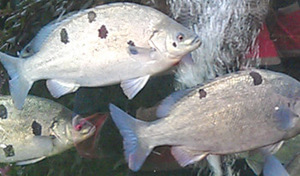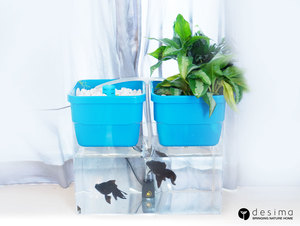CLICK HERE FOR YOUR FREE! Report On Aquaculture & Horticulture Integration (Aquaponics).
1. Environmental Conditions
- First consider your your environment, is it hot, cold or tropical? Choose a fish that suits your environmental conditions.
2. Feed Sources
- What food to you have access to feed your fish? Will you grow duckweed? Will you breed black soldier fly larvae?
3. Purpose
- Are you wanting fish to eat or just for producing waste to feed your plants?
4. Size How big will your fish tank be and how many fish will you stock? Is it a small desktop system, that is great for a siamese fighting fish(betta) or a big system, that would be great for delecious murray cod.
5. Is it legal? The fish you want, could be classified as an invasive species. So remember to check with the local fishery department.Use the infographic below to help you choose the best fish for your aquaponic system.

Remember if you use this infographic on your website, you must have a link back to this page and our home page www.desima.co
Edible Aquaponics Fish

Tilapia
Cichlid fall under the Tilapia species of fish and are a hardy fish found in freshwater shallow streams, ponds and rivers. Cichlids are a nutritious fish that is high in protein, but also can be kept for purposes of aiding your aquaponics plant system or even as pets. Tilapia species of fish can survive in a temperature of around 21-29 °C (70 to 85 °F) In the wild, Cichlid’s are mostly omnivores, however you can feed your tank Cichlid’s live or frozen animal food such as shrimp and bloodworms. An easy source of food would be sinking pellets or flake fish food, which are rich in protein and fiber. You can, occasionally, feed your Tilapia type fish green foods like spinach.

Catfish
Catfish are great as pets as well as for your aquaponics set up. Their colors and shapes vary and can be very pretty as an ornamental fish.
They are particularly great at cleaning the tank walls and substrate. They will, in turn, keep the algae under control and will recycle food and waste from other fish.
Catfish are also hardy fish and are not prone to disease or illness, but can get stressed if threatened by larger fish, so just be aware of who you put in the tank with them.
As they are bottom feeders or benthic, catfish will need to be fed food that sinks, like sinking pellets or a heavier type of frozen fish food.
In addition, they like to feed at night once the aquarium lights are out, so remember that for your feeding schedule.
As for preferred water temperature, anywhere between 20 and 24°C (68 to 75 °F) is good.A few varieties to consider are Zebra Pleco, Cory, Bristle-nosed catfish and Clown catfish.

Silver Perch
As Silver Perch can grow to a relatively large size, around 8kg or 600mm in length, you will need to consider the size of your tank.
The preferred temperature for Silver Perch, outside of spawning season is between 18 to 23°C (73 to 82°F).
As far as eating goes, they love green plants so some spinach, duckweed or azolla will do nicely

Jade Perch
The Jade Perch, whilst similar looking to the Silver Perch in shape, has a greenish hue to its upper region, hence their name.
They prefer warmer water, although cooler than their cousins, the Silver Perch. Favorable temperatures would be about 20 to 28°C (68 to 82 °F).
They, too, like an omnivorous diet and can be seen eating any green variety of plant or a fish food low in animal protein

Murray Cod
Murray Cod fish are reasonably new to the aquaponics lifestyle and in fact new to tank culture. They need space and are quick growing fish, so take that into account when setting up your aquarium.
They need to be fed often or they may just start eating each other. Not something you want to witness, so remember a high stocking density always.
They are a carnivorous fish, obviously, so be aware not to put them in a tank with smaller fish, even if the species is a Murray Cod. They will eat them!
A diet rich in protein and phosphorus is good, so be sure to check your fish food labels.
Ideal temperature, as they are originally a river fish, would be around 8 to 24°C (46 to 75 °F), so they can handle quite a cold tank.
On a side note, they’re a really popular fish to catch from the rivers in my home town and are absolutely delicious.

Barramundi
These fish are very popular in aquaponic systems and are often grown in the warmer months and with slightly mature stock. If you intend to eat your Barramundi, you will find they have a lovely clean, crisp taste.
As a tank fish, they will still love to eat fish and crustaceans, so a diet rich in frozen fish, shrimp or prawns will go down very nicely.
They do well in warmer temperatures so make sure the water is around 26 to 30°C (78 to 86 °F).

Traut
Besides being a great tasting fish, trout have a very quick growth rate as well as food conversion ratio, meaning they convert their digested food to “fertilizer” very fast.
They prefer a cooler temperature between 10 to 20°C (52 to 62 °F) and originally a river fish, they like to eat aquatic and terrestrial insects as well as other fish, leeches, crustaceans and worms.
For commercial food, you could try frozen bloodworm and dried shrimp.

Bluegill
Bluegills are probably one of the most unfussy fish. They will eat pretty much anything, but that doesn’t mean you must feed them just anything. Stick to a diet of insects, zooplankton, small fish and worms. Frozen bloodworms are good as well as any flake or pellet type of fish food.
In terms of a preferable temperature for the tanks water can range anywhere between 16 to 27°C (60 to 80 °F).
Ornamental Aquaponics Fish

Goldfish
Your hardiest and by far most popular pet fishes but also a great option for aquaponics. They have longevity, although you may not think so if you ever owned a goldfish as a child. Difference is that you are now an adult and know how to look after that passive, orange friend.
Goldfish will survive just nicely on flake fish food and prefer a temperature of around 10 to 23°C (50 to 74 °F).
If you intend to breed them, you will need to consider some plant cover – they are shy like that!

koi
Our beautiful bevy of fish species and are in fact from the Carp family of fish. Predominantly found in Asian communities, these picturesque fish are best grown in larger, ornamental type tanks or aquariums.
Due to their lovely variety of colors, you want to ensure the food you feed them is high in Beta Carotene, which will enhance and help keep their natural colors.
Huge omnivores, you can feed your fish lettuce, watermelon and peas, but it is best to rather do this using specific Koi fish food, as this has been accurately measured out for the best nutritional balance.
Happy in a slightly warmer environment, you can ensure water temperature is between 15 to 25°C (59 to 77 °F).
Koi work very well in an aquaponic system. Especially if you have system where you get to show of your fish.

Siamese Fighting Fish (Betta)
These fish are just stunning, with their goldfish style bodies but flowing fins and tails, they are just beauties to watch.
They have a very particular diet as well, in that they like live brine shrimp and bloodworm, although frozen will do too. In addition, you can make their main source of food, for sake of ease, Siamese Fighting Fish granules or pellets.
They should be fed 1-2 times daily and in small quantities, as they have a tendency to overeat.
Being a tropical fish you need to keep the water temperature at a warm 25 to 26°C (78 to 80 °F).
Warning! As they are fighting fish, you cannot put more than one Betta or Fighting Fish in the tank at a time. They will fight each other to the death!
Suggestion is to either go with a soriety of female bettas, but no less than 4, ensure your tank size is ideal.

White Cloud Mountain Minnow(Betta)
Another member of the Carp family, the White Cloud Mountain Minnow fish is as hardy as you will find, so perfect for an aquaponics system.
They are hardy and grow very easily and quickly.A standard small pellet or flake type fish food is perfect for these guys and they do very well in temperatures of around 18 to 26°C (64 to 79 °F).

Get the, "Aqua Garden"
The Aqua Garden is a desktop aquaponics system. Grow your own healthy organic produce at home. Aquaponics is a natural system where the fish waste feeds the plants and the plants clean the water for the fish. This is a great system for getting started, it's not as small as some other products on the market so it will be easier to maintain.
